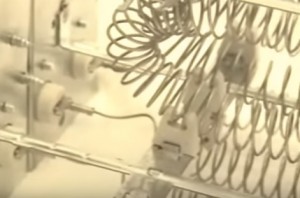
Electric heat is produced by converting electrical energy to heat. This is done by placing a known resistance of a particular material an electric circuit.
The resistance has relatively few free electrons and does not conduct electricity easily.
Resistance to electron flow produces heat at the point of resistance. One type of material used for this resistance is a special wire called Nichrome, for nickel chromium.
Electric heat is efficient but is more expensive to operate compared to many sources of heat. It is efficient because very little electrical energy is lost in the meter to the heating element.
It is expensive because it takes large amounts of electrical energy to produce the heat, and the cost of electrical energy in most areas of the country can be expensive compared to fossil fuels such as coal, oil, and gas.
Purchase price of electrical heating systems is usually less than other systems. The installation and maintenance is also usually less expensive. This makes electrical heating systems attractive to many purchasers.
What electrical heat is used as the primary heating source, a high value of insulation is normally used throughout the structure to lower the amount of heat required.
Types of electrical heating
Portable electric heating devices
Portable or small space heaters are sold in many retail stores and by many industrial distributors and manufacturers. Some have glowing coils do the resistance of the wire to electron flow. These transfer heat by radiation to solid objects in front of the heater. Radiant heat travels in a line of sight and is stopped by solid objects, warming the space around.
Radiant heat also provides heating comfort to individuals. The heat concentration decreases by the square of the distance and is soon dissipated into the space.
Glass panel heaters are also used to heat small spaces by radiation.
Other space heaters use bands move air over the heating elements and into the space. This is called force convection heating because the heat laden air is movement Canticle. Units may be designed to move in of air across the heating elements so they do not glow.
Radiant spot heating can be effectively used in doorways, warehouses, work areas, and even outdoors. The effect is much like a sun lamp pointing at the heated area. Distance has a direct bearing on the effectiveness of radiant heating.
Radiant heating panels
Radiant electrical heating panels are used in residential and light commercial buildings. The panel is often made of gypsum board with white heating circuits running throughout. The panels are usually installed in ceilings and controlled with individual room thermostats, this provides room or zone control.
Be particular careful when installing a cooling system with a radiant heat is provided.
Heating panels must have a good insulation behind or above to keep heat from escaping. The electrical convection are also on the back, so the conjunctions are you easily assessable attic.
The heat produced is even, easy to control, and tends to keep the mass of the room warm by its radiation. This makes items in the room pleasingly warm to the touch.
Electric baseboard heating
Baseboard heaters are popular convection heaters used for whole house, spot, or individual room heating.
They are economical to install and can be controlled by individual room thermostats. These thermostats are normally line voltage thermostats. Unused rooms can be closed off and the he turned down which makes baseboard heaters economical and certain applications.
Baseboard units are mounted on the wall just above the floor carpet. Outside walls are usually used. The heater is a natural draft unit. Air enters near the bottom, passes over the electric element, is heated, and rises in the room. As the air cools, it settles, setting up a natural convection air current.
Baseboard heat is easy to control, safe, quiet, and evenly distributed throughout the house.
Unit heaters
Unit heaters are usually suspended from the ceiling and use a fan to force the air across the elements into the space to be heated. These heaters are controlled with lime voltage thermostats.
Central forced air electric furnaces
Central forced air furnaces are used with ductwork distribute the heated air to rooms were spaces away from the furnace. The heating elements are factory installed in the furnace unit with the air handling equipment or they can be purchased as duct heaters and installed within the ductwork.
Centrally heaters are usually controlled by single thermostat, resulting and one control point no individual room or zone control exists.
In a vanished wood duck heaters is that the temperature and individual rooms or zones can be controlled with multiple heaters placed the ductwork system.
However, interlock system must be Incorporated. The interlock system will not allow power to reach the heating element unless the fan is operating, which keeps the heating elements overheating and possibly causing and fire.
The heating elements are made of a Nichrome resistant wire mounted on a ceramic or Mica insulation. They are enclosed in the ductwork with a furnace housing and electric furnace.
Air-conditioning cooling and humidification can usually be added because of the air handling feature.